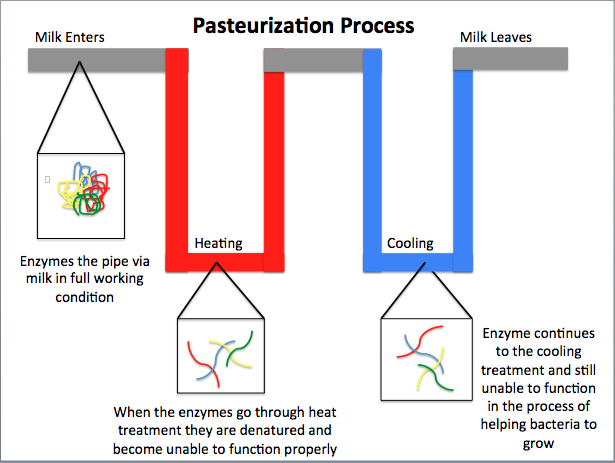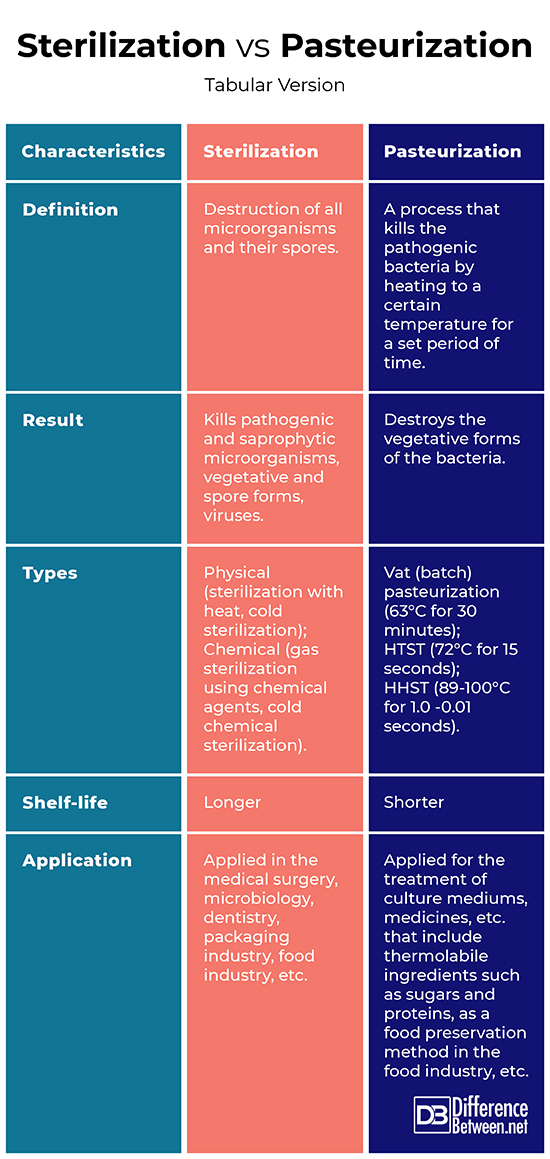Difference Between Sterilization and Pasteurization
Sterilization vs Pasteurization
Some of the microorganisms are useful and even necessary for everyday life. However, there are a huge number of microorganisms that can cause disease or damage to useful resources. Different methods are used in order to kill harmful microorganisms. The sterilization is a process that destroys all microorganisms and their spores, while the pasteurization destroys only the vegetative forms of the bacteria and the spores survive.
What is Sterilization?
Sterilization is a destruction of all microorganisms and their spores. The process kills pathogenic and saprophytic microorganisms, vegetative and spore forms, viruses.
Sterilization can be physical or chemical.
Physical sterilization is:
- Sterilization with heat;
- Cold sterilization.
Sterilization with heat is dry or wet. The first one uses hot air (combustion), and the second one – water vapor (boiling). With the temperature rise above the critical for the microorganisms, they quickly die. The critical threshold varies between the groups of micro-organisms. The vegetative forms of the bacteria are poorly resistant to heat, the viruses and molds are with an intermediate resistance, and the spores are the most resistant. The mechanism of action of the sterilization with heat is generally limited to irreversible changes in proteins in the cytoplasm (coagulation) and the inactivation of some important enzymes.
Cold physical sterilization is done with bacterial filters or with radiation. The radiation used for sterilization can be:
- Non-ionizing ultraviolet radiation;
- Ultrasound;
- Ionizing rays.
Practical application for sterilization have gamma rays from natural radioactive substances and high-speed electrons from high-voltage apparatus. They have a strong penetrating ability and the sterilized materials have a long shelf life.
Chemical sterilization is:
- Gas sterilization using chemical agents;
- Cold chemical sterilization.
Chemical sterilization can be done with:
- Halogen-containing preparations (containing chlorine or iodine);
- Phenol derivatives;
- Aldehydes;
- Alcohols;
- Oxidants;
- Surfactants;
- Guanidine compounds;
- Acids and bases;
- Combined preparations, etc.
The chemical compounds used for sterilization have different mechanisms of action, advantages, and disadvantages. For example, chlorine-containing compounds release chlorine, which leads to the formation of toxic chloramines in the bacterial cytoplasm. They have a wide spectrum of action and a strong bactericidal effect, but a lower virucidal, tuberculocidal, fungicidal and sporicidal effect. They emit a severe irritating odor and irritate the skin and mucous membranes in contacts. Aldehydes alkylate cellular proteins and nucleic acids of the microorganisms. They have bactericidal, sporicidal, fungicidal, and virucidal action. Aldehydes are toxic and irritating to the skin, mucous membranes, respiratory tract, eyes, and have a carcinogenic effect (formaldehyde). They have a strong irritating smell and high allergenic potential.
What is Pasteurization?
Pasteurization is a process that kills the pathogenic bacteria by heating to a certain temperature for a set period of time.
Pasteurization only destroys the vegetative forms of the bacteria. After the pasteurization, the products have to be stored in a refrigerator to prevent the development of the survived saprophytic bacteria.
The temperature range of the pasteurization is usually from 62 to 100°C. The time may vary from less than a second to half an hour. Depending on the temperature and the time, the pasteurization is:
- Vat (batch) pasteurization – 63°C for30 minutes;
- HTST – high temperature short time pasteurization – 72°C for 15 seconds;
- HHST – high heat short time pasteurization:
- 89°C for 1.0 second;
- 90°C for 0.5 seconds;
- 94°C for 0.1 seconds;
- 96°C for 0.05 seconds;
- 100°C – 0.01 seconds, etc.
Different pasteurization methods are used for different purposes. The choice of the pasteurization method generally depends on the type of the pasteurized product, its volume, purpose, the target microorganisms, the available equipment, etc.
Vat pasteurization is mainly used in the food industry and aims at killing the pathogenic microorganisms and increasing the shelf-life of the products. It kills the pathogenic microorganisms but preserves most of the physicochemical properties of the food products. It is used in the production of milk, beer, etc.
Pasteurization at higher temperatures aims at killing the vegetative pathogenic and spoilage bacteria, denaturing serum proteins, and avoiding syneresis. It is used in the production of cheese, yogurt etc.
By repeated pasteurization (tyndallization) it is possible to obtain a completely sterile product. This process is used for the treatment of culture mediums, medicines, etc. that include thermolabile ingredients such as sugars and proteins. Tyndallization is carried out for 30 minutes at a temperature of 100° C for a period of several days. The first heating aims to kill the vegetative forms. After the cooling, until the heating on the next day, the surviving spores grow, which allows the heat to destroy their vegetative forms.
Difference Between Sterilization and Pasteurization
-
Definition
Sterilization: Sterilization is a destruction of all microorganisms and their spores.
Pasteurization: Pasteurization is a process that kills the pathogenic bacteria by heating to a certain temperature for a set period of time.
-
Result
Sterilization: The process kills pathogenic and saprophytic microorganisms, vegetative and spore forms, viruses.
Pasteurization: Pasteurization only destroys the vegetative forms of the bacteria.
-
Types
Sterilization: Sterilization can be physical (sterilization with heat, cold sterilization) or chemical (gas sterilization using chemical agents, cold chemical sterilization).
Pasteurization: Depending on the temperature and the time the pasteurization can be Vat (batch) pasteurization (63°C for 30 minutes), HTST (72°C for 15 seconds), HHST (89-100°C for 1.0 -0.01 seconds).
-
Shelf-life
Sterilization: Shelf-life of the sterilized products is longer than the one of the pasteurized ones.
Pasteurization: Shelf-life of the pasteurized products is shorter than the one of the sterilized ones.
-
Application
Sterilization: Sterilization is applied in the medical surgery, microbiology, dentistry, packaging industry, food industry, etc.
Pasteurization: Pasteurization is applied for the treatment of culture mediums, medicines, etc. that include thermolabile ingredients such as sugars and proteins, as a food preservation method in the food industry, etc.
Sterilization vs Pasteurization : Tabular Version
Summary of Sterilization vs Pasteurization:
-
- Some of the microorganisms are useful and even necessary for the everyday life, but there are a huge number of microorganisms that can cause disease or damage to useful resources.
- Different methods are used in order to kill harmful microorganisms, including sterilization and pasteurization.
- Sterilization is a destruction of all microorganisms and their spores.
- Pasteurization is a process that kills the pathogenic bacteria by heating to a certain temperature for a set period of time.
- Sterilization kills pathogenic and saprophytic microorganisms, vegetative and spore forms, viruses. Pasteurization only destroys the vegetative forms of the bacteria.
- Sterilization can be physical (sterilization with heat, cold sterilization) or chemical (gas sterilization using chemical agents, cold chemical sterilization). Depending on the temperature and the time the pasteurization can be Vat (batch) pasteurization (63°C for 30 minutes), HTST (72°C for 15 seconds), HHST (89-100°C for 1.0 -0.01 seconds).
- Shelf-life of the sterilized products is longer than the one of the pasteurized ones.
- Sterilization is applied in medical surgery, microbiology, dentistry, packaging industry, food industry, etc. Pasteurization is applied for the treatment of culture mediums, medicines, etc. that include thermolabile ingredients such as sugars and proteins, as a food preservation method in the food industry, etc.
- Difference Between Gallstones and Cholecystitis - September 5, 2021
- Difference Between Constipation and Cramping - August 4, 2021
- Difference Between Whole Genome Sequencing and Microarray - May 6, 2021
Search DifferenceBetween.net :
5 Comments
Leave a Response
References :
[0]Brooks, G., K. Carroll, J. Butel, S. Morse, T. Mietzner. Melnick & Adelbergs Medical Microbiology. 25th edition. New York. McGraw-Hill Companies. 2010. Print.
[1]Koutchma, T. Pasteurization and Sterilization. Hoboken: Wiley Publishing. 2012. Print.
[2]Sabatine, M. (Ed.). Pocket Medicine. 6th edition. Hong Kong: Wolters Kluwer. 2017. Print.
[3]Image credit: https://commons.wikimedia.org/wiki/File:Simple_Pasteurization.png
[4]Image credit: https://commons.wikimedia.org/wiki/File:Sterilization.jpg




It is very short and understandable so nice i pass my exam because of my definition am so grateful because it was quite unique
Excellent article, Thanks.
Could you please advise, on following two questions
1. Is it necessary to cool the milk to 4 degree after HTST?
2. if flavoured milk can is sterilised in retort machine at 123 degree after final packaging, do we still need pasteurization of milk before packaging? If yes, what kind of pasteurization should be used for it? (Vat or that?)
Very well explained ☺️
Wow!! Thanks for such a necessary Information!!
Thank you for that elaborate explanation..